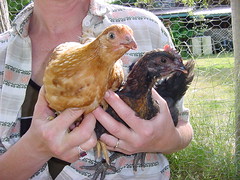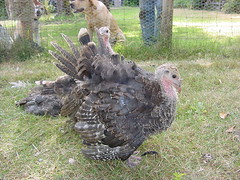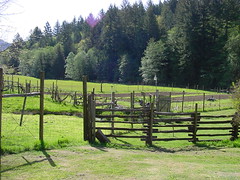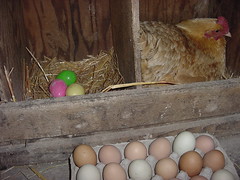
I was expecting lambs any day. But the days dragged on past the earliest possible due date as I checked and rechecked my gestation chart. March turned into April and on and on the days passed with no lambs. And then it rained and the sheep were scattered to the farthest corners of the pastures, and, of course, we started to have lambs.
The first ewe to lamb had triplets! What a start. The problem with three, besides the ewe only having two teats, is that it is hard to pick them up all at once to bring into the barn, from far away, in the rain, in the mud. Sorry little rag dolls, still damp from birth. I had help with this first lot, though. It was Easter weekend and our daughter and boyfriend were visiting. Always ready to take one of the ATVs out to explore, Randy was the first to discover the newborns in the back pasture underneath cover of some large alders near Honey Grove Creek. He raced back to the house with the news. Greg and I walked out to check, scooped the unsuspecting lambs off the ground, and hiked back to the barn with a worried mom circling our legs. It had started.
These first lambs looked quite healthy and handsome: two black boys and a fawn colored girl. When Karen and Allen, my cow herding neighbors, who were on their way to becoming lamb nursemaids as well, stopped by the next day, we (Karen and myself) simultaneously came up with the name 'Bambi' for the little girl. So, Bambi has a name, even though it is bad form to name a lamb meant for slaughter.
To answer the question, "How do you pick up three lambs at once by yourself?", something I had to do within the next several days, this is the trick. You stick one lamb inside the front of your jacket, zip it up as tightly as possible and hoist the other two under each arm. I have to stay crouched over as I walk to the barn so the ewe will not lose the smell or sight of her little ones. It is by the grace of God we all make it back to the cozy stalls, me heaving and ready to drop a lamb at any moment; the ewe circling and grunting and trying to trip me up; the lambs wriggling and calling out; the dogs only adding to the confusion.
Such close quarters as wrapping a lamb in one's clothing, or placing it on one's lap for various veterinary duties required within the first several days of birth, carries a certain essence with it. I have named this essence "eau-de-lamb". I am not particularly fond of the smell of sheep, being more accustomed to that sweet smell of horses, yet, at this time of year, with lambs popping out all over, I wear eau-de-lamb on my jeans, in my hair, on my hands, that even a good wash with essential oil soap can't kill. Eau-de-lamb is not a fancy french dish made with mushrooms and wine, instead it is a farm perfume blending lamb poop, colostrum milk, lanolin, and a little baby pee added to the mix. It's a wonder people don't give me a wider berth down at the Mercantile as I wander around looking for baby nipples to fit on my old, scratched, baby bottles from last year's bummer lamb crop. But then, this is a town of loggers and farmers, up before dawn, and, after a hard day of sweating, smelling worse than any eau-de-lamb. Well, not worse, but not really any better either.
In all, this was a good year for lambing (so far). What this means is I didn't have to intercede in even one birth. We had three sets of triplets and several singletons (one of which weighed 18 pounds!). The rest were the normal twins. Total number: 23! My vet neighbor, Liz, had even said she wanted to come down just to pull a lamb (help with a difficult birth), and then it wasn't necessary. Wouldn't you just know I get a fantastic offer like that and don't even have a use for it?! At least I can invite her down to watch the lambs leap around as they play tag in the orchard. I think if Liz hadn't been a vet she would have made a good obstetrician since she loves baby animals...although lambs, with their soft curly wool, seem cuter than babies at this time of year.
There was one surprise death and one bummer lamb out of the group. The death happened so suddenly I wasn't even aware there was a serious problem until it was all over. One of my triplet sets had been out and about for several days with their mom. As I gazed over the fence to watch them race back to the barn, one of the lambs fell down and didn't try to get up. I waited a moment because lambs and sheep have this peculiar habit of getting stuck lying down, and I thought a few wiggles and the lamb would set herself to rights. When she continued to lie there, I decided to go over and pick her up. She felt light and weak to me. I place her next to her mother only to watch her be pushed aside as the ewe walked off with her other two lambs. I knew this routine. It looked like a classic rejection, so I decided to bring the lamb into the house for some milk and a good dose of vitamins. She was small and white and figured out how to drink from the bottle almost immediately. Not gulping, not hysterically hungry, just sucking until she had downed about 6 ounces. She lay down and made several mewing noises as I left her to sleep and went on to finish my own dinner. When I came back 5 minutes later, she was dead. I have no idea what happened.
Snickers became our 'bummer' lamb, a lamb whose mother rejects it despite all efforts on my part to keep this from happening. Snicker's mother was the wildest of our new Katahdins and Allen, Karen and I had been unsuccessful catching her right after her twins were born, to place in a stall for the night until adequate bonding had taken place. The lambs hung with their mother until the third morning when I came out to the barn and Snickers was lying in a prone position, head over his back, shivering with the cold, his mother and sister nowhere in sight. I picked him up and hurried back to the house for a heat lamp and some warm milk. The inside of his mouth was cold (death is imminent). I left the water to run hot in the sink as I read the back of the 25 lb bag of Milk Replacer. How could I forget the formula after using up two bags of this stuff only 6 months earlier?! Like most young lambs, Snickers had no desire to suck on a baby nipple until he tasted the warm, sweet milk trickle down his throat. One fear for a lamb suffering hypothermia is the lack of either will or strength left to suck on a bottle. No problem here! Snickers would have inhaled the stuff if he could have. 4 ounces later and he was ready for a nap in a box of straw I had set up in the kitchen with an old clip-on light attached.
Rather like the ugly duckling in the fairy tales, Snickers was an ugly lamb. I didn't actually think something like this could happen but all my friends agreed that he was indeed ugly. His pink skin shone through a light dusting of wool; his legs were long; his head small. We actually discussed how he looked like the leg of a turkey after it has been plucked! He needed a name but all we could come up with was Tom, Turk, Hairless Wonder, none of the names really seemed to fit. In the course of living in the house with us, the lamb had taken to Greg and, as he lay at Greg's feet in the study in his make-shift diapers (no, you cannot let a lamb just wander around without some sort of protection or the carpet will smell like eau-de-lamb forever ... sort of like cat pee), Greg suddenly announced he knew the lamb's name. Snickers had told him. I will admit there are times when names just present themselves for animals, and they are the right name, and Snickers was definitely the right name.
Snickers stayed with us in the house for several nights, sent out to play with the other lambs during the day. It is still cool here and we didn't want a repreat of the first time we found him alone. Too soon, Snickers had learned how to climb out of his box and the tap of his hooves on the wood floors made it hard to sleep at night. He would curl up next to the bed, but soon we had all had enough. The cats on the bed were edgy; the dogs didn't know what to think. Besides this, the lamb was growing so quickly the diapers not longer fastened and I had had to fashion a Safeway shopping bag into a wet suit raincoat, with a diaper thrown into the bottom for absorption, to try and contain any damage. I never knew a lamb could pee so much, or directly forward (boy thing).
Our rescue, from becoming overly besotted with this little lamb, came this week in the form of a small 4-year-old girl and her grandmother who live up the road. Snickers has been adopted into their famiy as a project on care-taking and responsibility. Both Snickers and the little girl now have a new best friend as they follow each other around during the day. Soon he will have two young kid goats to play with in the back yard too, and we will visit from time to time, but I think our ugly duckling has already turned into a beautiful white swan.
Of course, it has started to rain again and just this morning I found a new lamb lying in the mud, barely moving, the ewe baa-ing and circling. I picked up the limp white body with black markings on its nose, tried to wipe the dirt from its face still covered in yellow amniotic fluid, and carried it into the barn. There is fresh hay in the stall; the red heat lamp is turned on; I made sure there is clean water and some grain for the mom. I'll check back later in the day to see how the pair are doing. Right now I need to go down to the post office, perfumed in eau-de-lamb, hoping I will not have a Snickers II to deal with when I return, hoping all will turn out well and, soon enough, this small one will join the other leaping lambs in our orchard.
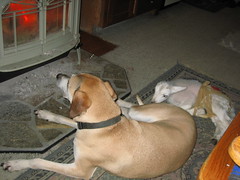 (Snickers fell asleep on the lamb rug which seemed appropriate. He also liked to curl up next to Cisco in front of the wood stove, although Cisco didn't really like to be touched.)All Rights Reserved. Copyright 2007 Scottie Jones
...Click here to read the rest of this post.
(Snickers fell asleep on the lamb rug which seemed appropriate. He also liked to curl up next to Cisco in front of the wood stove, although Cisco didn't really like to be touched.)All Rights Reserved. Copyright 2007 Scottie Jones
...Click here to read the rest of this post.






+Oct+2007+014.jpg)
+063.jpg)
+Oct+2007+001.jpg)
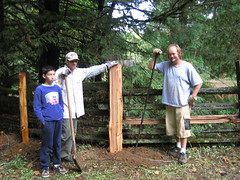
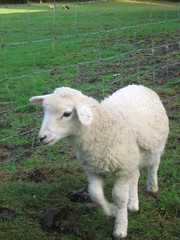
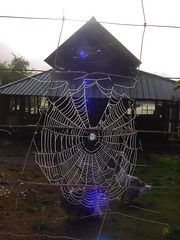
+Aug+2007+028.jpg)
+Aug+2007+044.jpg)

